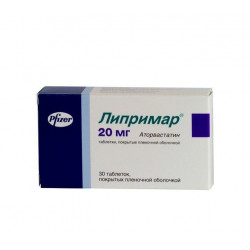



 All payments are encrypted via SSL
All payments are encrypted via SSL
 Full Refund if you haven't received your order
Full Refund if you haven't received your order
Pills
Atorvastatin (in the form of Calcium salt).
Excipients: calcium carbonate, microcrystalline cellulose, lactose monohydrate, croscarmellose sodium, polysorbate-80, hyprolosis, Magnesium stearate.
30 pieces
LIPRIMAR is a lipid-lowering agent from the group of statins. According to the principle of competitive antagonism, the statin molecule binds to the part of the coenzyme A receptor where HMG-CoA reductase is attached. Another part of the statin molecule inhibits the conversion of hydroxymethylglutarate to mevalonate, an intermediate product in the synthesis of the cholesterol molecule. Inhibition of the activity of HMG-CoA reductase leads to a series of consecutive reactions, which result in a decrease in the intracellular cholesterol content and a compensatory increase in the activity of LDL receptors and, accordingly, an acceleration of cholesterol catabolism (Xc) of LDL.
The lipid-lowering effect of statins is associated with a decrease in total Xc due to Xc-LDL. A decrease in the level of LDL is dose-dependent and is not linear, but exponential. The inhibitory effect of atorvastatin&№174; on HMG-CoA reductase is approximately 70% determined by the activity of its circulating metabolites.
Statins do not affect the activity of lipoprotein and hepatic lipases, do not have a significant effect on the synthesis and catabolism of free fatty acids, therefore their effect on the TG level is secondary and indirectly through their main effects on reducing the level of Xc-LDL. A moderate decrease in the level of TG in the treatment with statins seems to be associated with the expression of the remnant (apo E) receptors on the surface of hepatocytes involved in the catabolism of LPPP, which are approximately 30% TG. Compared with other statins (with the exception of rosuvastatin), atorvastatin&№174; causes a more pronounced decrease in TG levels.
In addition to the lipid-lowering action, statins have a positive effect on endothelial dysfunction (preclinical sign of early atherosclerosis), on the vascular wall, atheroma, improve the rheological properties of blood, have antioxidant, anti-proliferative properties.
Atorvastatin&№174; reduces cholesterol levels in patients with homozygous familial hypercholesterolemia, which usually does not respond to therapy with lipid-lowering drugs.
Primary hypercholesterolemia with the ineffectiveness of diet therapy, combined hypercholesterolemia and hypertriglyceridemia, heterozygous and homozygous familial hypercholesterolemia with the ineffectiveness of diet therapy.
Liver diseases in the active stage, increased serum transaminase activity more than 3 times of unclear genesis, pregnancy, lactation (breastfeeding), hypersensitivity to Atorvastatin. Women of reproductive age who do not use reliable contraception.
Contraindicated.
The treatment is carried out against the background of a standard diet for patients with hypercholesterolemia. Dose set individually, depending on the initial level of cholesterol. Is ingested. The initial dose is usually 10 mg 1 time / The effect occurs within 2 weeks, and the maximum effect - within 4 weeks. If necessary, the dose can be gradually increased with an interval of 4 weeks or more. The maximum daily dose is 80 mg.
Gastrointestinal: constipation, flatulence, dyspepsia, abdominal pain, nausea, diarrhea.
Nervous system: headache, insomnia.
Other: asthenia, myalgia.
Before and during treatment with Atorvastatin&№174;, especially when symptoms of liver damage appear, it is necessary to monitor indicators of liver function. With an increase in the level of transaminases, their activity should be monitored until normalization. If the activity of AST or ALT, more than 3 times higher than normal, is maintained, it is recommended to reduce the dose or cancel atorvastatin.
When symptoms of myopathy appear during treatment, the activity of CPK should be determined. If a significant increase in the level of CPK is maintained, then it is recommended to reduce the dose or stop atorvastatin.
The risk of myopathy during treatment with atorvastatin increases with the simultaneous use of cyclosporine, fibrates, Erythromycin, antifungal drugs related to azoles, and niacin.
There is a possibility of the following adverse reactions, but not all cases have a clear connection with taking atorvastatin: muscle cramps, myositis, myopathy, paresthesia, peripheral neuropathy, pancreatitis, hepatitis, cholestatic jaundice, anorexia, vomiting, alopecia, pruritus, rash, impotence, hyperglycemia and hypoglycemia.
In children, the experience of using Atorvastatin&№174; in a dose of up to 80 mg / limited.
Atorvastatin&№174; is used with caution in patients with chronic alcoholism.
With simultaneous use of Atorvastatin&№174; with Digoxin, the concentration of digoxin in the blood plasma slightly increases.
Diltiazem, Verapamil, isradipine inhibit the CYP3A4 isoenzyme, which is involved in the metabolism of atorvastatin, therefore, with the simultaneous use of calcium channels with these blockers, it is possible to increase the concentration of atorvastatin in the blood plasma and increase the risk of myopathy.
With the simultaneous use of itraconazole, the concentration of atorvastatin in the blood plasma significantly increases, apparently due to the inhibition by itraconazole of its metabolism in the liver, which occurs with the participation of the CYP3A4 isoenzyme; increased risk of myopathy.
With simultaneous use of colestipol may decrease the concentration of atorvastatin in the blood plasma, while the lipid-lowering effect is enhanced.
With the simultaneous use of antacids containing magnesium hydroxide and aluminum hydroxide, reduce the concentration of Atorvastatin&№174; by about 35%.
With simultaneous use of cyclosporine, fibrates (including gemfibrozil), antifungal drugs derived azole, nicotinic acid increases the risk of myopathy.
With the simultaneous use of erythromycin, Clarithromycin moderately increases the concentration of Atorvastatin&№174; in the plasma, increases the risk of myopathy.
With simultaneous use of ethinyl estradiol, norethisterone (norethindrone), the concentration of ethinyl estradiol, norethisterone and (norethindrone) in the blood plasma slightly increases.
With the simultaneous use of protease inhibitors, the concentration of Atorvastatin&№174; in the blood plasma increases, because protease inhibitors are inhibitors of the CYP3A4 isoenzyme.
Liprimar